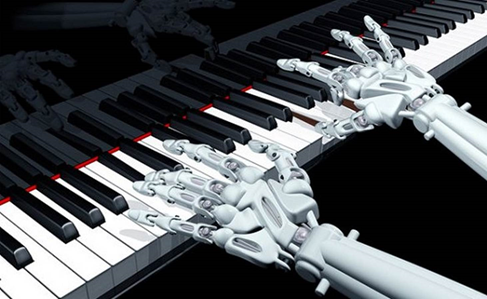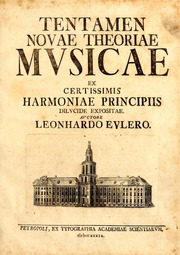This I'm sure is the question on everyone's minds this crisp Family Day holiday afternoon in Canada: Is there an objective technical standard for composing original, quality music (ie. a methodology that could be used by machines to create music independently of human insight)?
The great 18th century mathematician, Leonhard Euler, essentially attempted to figure this out.
In Euler’s era, music underwent a revolution driven by mathematics resulting in dramatic new applications of harmony & key never before possible
This new sound was unlike anything ever heard before, adding huge new level of richness that medieval counterpoint could not dream of.
This new sound was unlike anything ever heard before, adding huge new level of richness that medieval counterpoint could not dream of.
This of course drew the fascination of mathematicians as to what made some sounds pleasing, and others not so much.
And a foolproof formula for putting them together.
And a foolproof formula for putting them together.
In 1731, Euler wrote his ‘Tentamen novae theoriae musicae ex certissimis harmoniae principiis dilucide expositae’
- or -
‘An attempt at a new theory of music, exposed in all clearness according to the most well-founded principles of harmony.’
Love this title. Badass.
- or -
‘An attempt at a new theory of music, exposed in all clearness according to the most well-founded principles of harmony.’
Love this title. Badass.
Euler’s paper was said to be too musical for mathematicians, and too mathematical for musicians.
You’ll see why. . .
You’ll see why. . .
Euler’s core precept about music: Pleasure in music comes at the listener’s perception of perfection.
This would, perhaps unsurprisingly, be suggestive that there are natural laws or mathematical rules driving the process.
Or an underlying order that could be replicated.
This would, perhaps unsurprisingly, be suggestive that there are natural laws or mathematical rules driving the process.
Or an underlying order that could be replicated.
Euler chose the pitch (or frequency of vibration) of a sound as its organizing feature.
This is Euler's building block of the mathematical rule of what constitutes a pleasurable sound.
This is Euler's building block of the mathematical rule of what constitutes a pleasurable sound.
Rejected alternatives included Duration (the length of time a note or tone, or pitch is sounded) and Intensity, which was too hard to define exactly.
Euler’s objective was much more ambitious than the Greeks and others had pursued in their analysis of music.
In his chapter "On the charms and principles of the harmony", Euler sought to define a scale of ‘kindness’ of the sound aggregations (ie. total vibrations) making up each sound.
Euler then put them into a ratio defining relationship between any number of sounds. He called this the "suavitatis gradus". Auditory result was a ‘degree of softness’
What listener hears is the ratio of the two sounds, or the “rationem sesquialteram" in that degree of softness.
What listener hears is the ratio of the two sounds, or the “rationem sesquialteram" in that degree of softness.
With this, a system of music starts to appear (here with the simplest 2-note chords, but extendible to any number):
A single note, or two notes in unison gives the simplest order. Ratio 1:1, corresponding to the first degree of softness.
A single note, or two notes in unison gives the simplest order. Ratio 1:1, corresponding to the first degree of softness.
Ratio 1:2, that of the octave, gives next simplest order: 2nd degree of softness.
Ratios 1:3 & 1:4 still fairly simple.
1:3 (that of the fifth of the higher octave) comprises smaller numbers, but 1:4 is double of the double proportion (double octave) which is easy to perceive.
Ratios 1:3 & 1:4 still fairly simple.
1:3 (that of the fifth of the higher octave) comprises smaller numbers, but 1:4 is double of the double proportion (double octave) which is easy to perceive.
They are both in the third degree of softness.
Euler attaches then the n+1 degree to the ratio 1:2n, each power of 2 incrementing the degree by a unit.
Euler attaches then the n+1 degree to the ratio 1:2n, each power of 2 incrementing the degree by a unit.
Then noticing, that 1:5 must be more complex than 1:8 (= 1:23), which has degree 4, Euler allots degree 5 to it and deduces by induction that for a prime number p, 1:p is degree p.
So Euler objectively calculated the consonance of a sound, or harmony, by its calculated degree of softness.
Has music been 'solved', or automated, relegating past or future Bachs or Rachmaninovs to historical curiosities?
Has music been 'solved', or automated, relegating past or future Bachs or Rachmaninovs to historical curiosities?
Euler has objectively calculated the consonance of a sound, or harmony, by its calculated degree of softness.
He has defined the ‘complete chord’, a chord where one can add no note to it w/o its degree becoming higher, therefore without its exponent not becoming more complex.
He has defined the ‘complete chord’, a chord where one can add no note to it w/o its degree becoming higher, therefore without its exponent not becoming more complex.
It follows that a chord is complete if it includes all the dividers of its exponent. The ear will then have the impression of plenitude in this degree of chord.
This system appears to work with any combination of notes & chords, & w progressions of chords versus a single chord.
This system appears to work with any combination of notes & chords, & w progressions of chords versus a single chord.

 Read on Twitter
Read on Twitter



